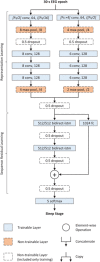Comparison of deep transfer learning algorithms and transferability measures for wearable sleep staging
- PMID: 36096868
- PMCID: PMC9465946
- DOI: 10.1186/s12938-022-01033-3
Comparison of deep transfer learning algorithms and transferability measures for wearable sleep staging
Abstract
Background: Obtaining medical data using wearable sensors is a potential replacement for in-hospital monitoring, but the lack of data for such sensors poses a challenge for development. One solution is using in-hospital recordings to boost performance via transfer learning. While there are many possible transfer learning algorithms, few have been tested in the domain of EEG-based sleep staging. Furthermore, there are few ways for determining which transfer learning method will work best besides exhaustive testing. Measures of transferability do exist, but are typically used for selection of pre-trained models rather than algorithms and few have been tested on medical signals. We tested several supervised transfer learning algorithms on a sleep staging task using a single channel of EEG (AF7-Fpz) captured from an in-home commercial system.
Results: Two neural networks-one bespoke and another state-of-art open-source architecture-were pre-trained on one of six source datasets comprising 11,561 subjects undergoing clinical polysomnograms (PSGs), then re-trained on a target dataset of 75 full-night recordings from 24 subjects. Several transferability measures were then tested to determine which is most effective for assessing performance on unseen target data. Performance on the target dataset was improved using transfer learning, with re-training the head layers being the most effective in the majority of cases (up to 63.9% of cases). Transferability measures generally provided significant correlations with accuracy (up to [Formula: see text]).
Conclusion: Re-training the head layers provided the largest performance boost. Transferability measures are useful indicators of transfer learning effectiveness.
Keywords: Domain adaptation; EEG; Machine learning; Sleep staging; Transfer learning; Wearable medical devices.
© 2022. The Author(s).
Conflict of interest statement
The authors declare that they have no competing interests.
Figures
Similar articles
-
Physics-Informed Transfer Learning to Enhance Sleep Staging.IEEE Trans Biomed Eng. 2024 May;71(5):1599-1606. doi: 10.1109/TBME.2023.3345888. Epub 2024 Apr 22. IEEE Trans Biomed Eng. 2024. PMID: 38133969
-
Ensemble machine learning model trained on a new synthesized dataset generalizes well for stress prediction using wearable devices.J Biomed Inform. 2023 Dec;148:104556. doi: 10.1016/j.jbi.2023.104556. Epub 2023 Dec 2. J Biomed Inform. 2023. PMID: 38048895
-
From unsupervised to semi-supervised adversarial domain adaptation in electroencephalography-based sleep staging.J Neural Eng. 2022 Jun 24;19(3). doi: 10.1088/1741-2552/ac6ca8. J Neural Eng. 2022. PMID: 35508121
-
Estimating Biomechanical Time-Series with Wearable Sensors: A Systematic Review of Machine Learning Techniques.Sensors (Basel). 2019 Nov 28;19(23):5227. doi: 10.3390/s19235227. Sensors (Basel). 2019. PMID: 31795151 Free PMC article.
-
Automated sleep scoring: A review of the latest approaches.Sleep Med Rev. 2019 Dec;48:101204. doi: 10.1016/j.smrv.2019.07.007. Epub 2019 Aug 9. Sleep Med Rev. 2019. PMID: 31491655
Cited by
-
Survey of Transfer Learning Approaches in the Machine Learning of Digital Health Sensing Data.J Pers Med. 2023 Dec 12;13(12):1703. doi: 10.3390/jpm13121703. J Pers Med. 2023. PMID: 38138930 Free PMC article. Review.
-
Breaking Diagnostic Barriers: Vision Transformers Redefine Monkeypox Detection.Diagnostics (Basel). 2025 Jul 3;15(13):1698. doi: 10.3390/diagnostics15131698. Diagnostics (Basel). 2025. PMID: 40647697 Free PMC article.
-
Transfer Learning for Automatic Sleep Staging Using a Pre-Gelled Electrode Grid.Diagnostics (Basel). 2024 Apr 26;14(9):909. doi: 10.3390/diagnostics14090909. Diagnostics (Basel). 2024. PMID: 38732323 Free PMC article.
-
Sleep-Deep-Net learns sleep wake scoring from the end-user and completes each record in their style.bioRxiv [Preprint]. 2023 Dec 23:2023.12.22.573151. doi: 10.1101/2023.12.22.573151. bioRxiv. 2023. Update in: Sleep Adv. 2024 Apr 04;5(1):zpae022. doi: 10.1093/sleepadvances/zpae022. PMID: 38187568 Free PMC article. Updated. Preprint.
-
Optimizing wearable single-channel electroencephalography sleep staging in a heterogeneous sleep-disordered population using transfer learning.J Clin Sleep Med. 2025 Feb 1;21(2):315-323. doi: 10.5664/jcsm.11380. J Clin Sleep Med. 2025. PMID: 39347545
References
-
- Iber C. American Academy of Sleep Medicine . The AASM manual for the scoring of sleep and associated events : rules, terminology and technical specifications. Westchester: Am Acad Sleep Med; 2007. Section: 59 str. : ilustr. ; 28 cm.
-
- Nazeran H, Krishnam R, Chatlapalli S, Pamula Y, Haltiwanger E, Cabrera S. Nonlinear dynamics analysis of heart rate variability signals to detect sleep disordered breathing in children. In: 2006 International Conference of the IEEE Engineering in Medicine and Biology Society; 2006. p. 3873–3878. ISSN: 1557-170X. - PubMed
MeSH terms
LinkOut - more resources
Full Text Sources



